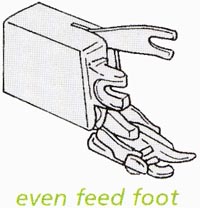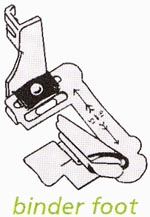|
The walking or even-feed foot is used to sew hard-to-feed napped or pile fabrics, stretch fabrics, plaids and stripes, slippery fabrics, or multiple layers of fabrics that may shift or hang up on each other. The top layer of fabric is helped along at the same rate as the bottom fabric. A ruffler can make uniform gathers or tiny pleats on light- to medium-weight fabrics: it can ruffle one layer and stitch it to a flat fabric, lace can be inserted while ruffling, and tiny pleats can be sewn in intervals. The bias binder attachment or foot is used to apply purchased or self-fabric bias binding to a cut edge. The binding is rolled around the edge, or pre-folded tape may be used. Teflon feet have a coated sole that is helpful in stitching on leathers, vinyl, suede and other “sticky” fabrics. Another foot designed to handle these same difficult fabrics is the roller foot. Designed with one or more rollers, the upper fabric is kept from slipping while stitching. Pin tuck feet , also available in sizes based on the weight of the fabric are used in conjunction with the double needle. The grooves on the bottom of the foot create tiny raised tucks in the fabric. Braiding, cording, felling, free-motion or darning, and quilting or patchwork feet are just a few of the many other specialty feet available. |
   (continued at bottom of page...) |
Are you looking for sewing or crafts-related items such as sewing machines, sergers, yarn, and knitting supplies? Try our online catalog pages here:
Or see what products on our site the popular search engines have chosen to list...
- Google listing
of all "Sewing Machine" items on our site
- Yahoo! listing
of all "Sewing Machine" items on our site
- Alta Vista listing of all "Sewing Machine" items on our site
Recommended Reading
Recommended Products
If you need specific sewing supplies, browse through the products on pages like these:
There are many more specialty feet available designed to make your sewing projects easier. Ask your local authorized sewing machine dealer for a list of those made for your brand machine. Take classes to learn more about the feet and what they will do for you.
Be sure to use the correct bobbins for your model machine. Bobbins can be either made of plastic or metal so consult your sewing machine’s manual before purchasing additional ones. It is recommended to keep several on hand, wound with your basic colors. Avoid winding one color thread over another or using damaged or nicked bobbins, as they may cause stitching problems.
Keep your sewing machine tools handy, as they are an important part
of your machine. Needles and some presser feet may need to be removed
and attached with a small screw driver. If your machine needs to be
oiled, do so prior to beginning your sewing project rather than when
you are finished so the oil gets worked through the machine’s moving
parts while you sew. And, keep your bobbin area and around the feed
dogs free of lint for a smoother-working machine.
